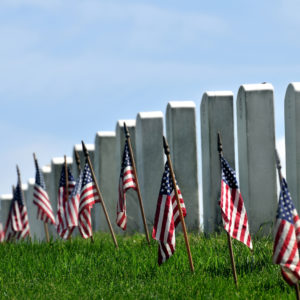From the U.S. Capitol’s corridors of legislative power you can walk in a direct line down the length of the National Mall to the Lincoln Memorial, passing by on your way the impatient horses of the Grant Memorial; the world’s — and America’s — cultural and industrial history curated away as so many artifacts in the Smithsonian museums to your left and right; by Washington’s obelisk encircled by the nation’s flag; and by the dramatic memorials of America’s later 20th-century wars. But from the Lincoln Memorial, since 1932 and the completion of Memorial Bridge and Memorial Avenue, the terminus of the capital plan’s axis has been Arlington National Cemetery.
For many visitors, their terminus within Arlington Cemetery is the Tomb of the Unknown Soldier, where they watch duty on display as sentinels of the Old Guard stand vigilant, in honor of the dead. But behind the Memorial Amphitheater, past the Spanish War Memorial and against a background of evergreens, is the Nurses Memorial and Section 21. Here is the final resting place of Army, Navy and Air Force nurses.
Jane Delano is buried here, whose father died in the Civil War. She served in the Army Nurse Corps, and in 1912 almost single-handedly created the American Red Cross Nursing Service, which became the recognized nursing reserve for the Army, Navy and Public Health Service. Even today the Red Cross Nurse remains a powerful symbol of care and service in our national iconography.
The rows upon rows of uniform white markers, each bearing a person’s name, which make up the quiet architecture of Section 21, Arlington Cemetery, and all American national cemeteries, make up individual answers to the perpetual question of how to measure the cost of war. Between the American Revolution in 1775 and the Persian Gulf War in 1991, the U.S. Department of Veterans Affairs estimates that there have been approximately 651,031 “battle deaths” alone. Of U.S. military men and women killed in action since October 2001, there have been 5,429, according to the Department of Defense. There are thousands upon thousands more who have died as a result of battlefield injuries, or have died as captured POWS, or have gone missing. But there are also thousands who’ve survived their severe wounds. Since the initiation of the national cemetery system in response to the Civil War, more and more soldiers are surviving the battlefield thanks to innovations in combat medicine aided by advances in transportation and technology.
It’s not often that we pause to think, on Memorial Day or any other day, of the lives saved by war. Not the lives of whole populations saved from genocide by some war to topple a tyrant, (though that is a weighty consideration too), but the lives of future soldiers, and the lives of present civilians, who are saved by the discoveries of medics and military doctors in wartime.
“He who wishes to be a surgeon should go to war,” is a saying ascribed to Hippocrates, the ancient Greek “Father of Western Medicine.”
Lessons learned in Korea and Vietnam sparked the development of civilian paramedics, modern trauma centers, civilian air ambulance services and MEDEVAC. Over the last 18 years of continuous military operations, the U.S. military has again completely transformed trauma care. Whereas in the civilian world it takes an average of 17 years for a new discovery to change medical practice, the U.S. military developed and fielded more than 27 major innovations over the wars in Iraq and Afghanistan. These innovations decreased by half the death rate from battlefield wounds, to the lowest level in the history of warfare.
And two of these — the Combat Application Tourniquet, and field bandages with hemostatic agents, are now available commercially and used by increasing amounts of civilian first responders. Not only are they saving military lives, they are saving thousands more lives across the United States, especially lives endangered by motor vehicle accidents and violent shootings.
Since the practice of Memorial Day first began in the aftermath of the Civil War, the American people have asked themselves two questions on this day: How to remember and honor the sacrifice of its military dead, and how to understand the relationship between the dead, the nation for which they died, and the living. And Lincoln’s words at Gettysburg Cemetery have ever nourished the most profound response — that the dead’s commission to the living is to dedicate themselves to the “great task” of self-government.
Within that task, however, there remains space to think on how many of the living will have owed their lives to war.

